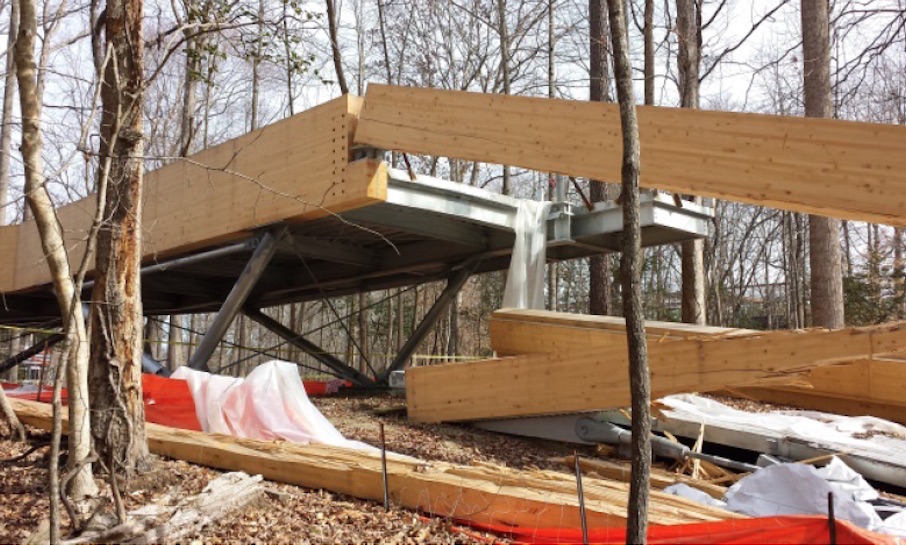An engineering company whose error led to two pedestrian bridge collapses in North Carolina in 2014 that left one worker dead and caused costly damage contends it is being unfairly denied $2 million in potential insurance coverage by its carrier due to what it claims is an “ambiguous” wording of the policy.
Raleigh-based Stewart Engineering is suing Continental Casualty Co., a unit of CNA, in federal court in North Carolina, arguing that the insurer is refusing to honor the terms of its policy that provides up to $5 million to cover multiple claims in a single year and is instead only offering $3 million.
The lawsuit was filed last year and remains unresolved. In it, CNA contends the collapses of the two glulam timber bridges are similar enough to trigger a “related claims” clause under which they are effectively treated as a single claim, with coverage capped at $3 million.
Represenatives of Stewart Engineering could not be reached before posting of this story for comment on the litigation. Neither could an attorney or representative for CNA, the big Chicago-based insurer.
The two pedestrian bridges were under construction on the campus of Wake Technical Community College in Raleigh, N.C. when they collapsed within 12 hours of each other on Nov. 13 and Nov. 14, 2014. The first collapse killed a construction worker, triggering a wrongful death lawsuit against companies involved in the project's design and construction, while the second collapse triggered further claims.
Investigators for the U.S. Occupational Safety and Health Administration refrained from citing Stewart since it had no staff on site, saying the engineering firm’s responsibility was limited to the design.
But OSHA referred the issue to the North Carolina Board of Examiners for Engineers and Surveyors, which reprimanded Stewart and levied a $5,000 fine. The board found Stewart had provided “inadequate” quality assurance and quality control and “should have recognized and raised concerns about the inadequate design and not documenting the completion of QA/QC checks … and employees failed to adequately address communicated concerns with the design.”
Stewart has told ENR that it has revamped its quality control procedures.
In the wrongful death lawsuit, filed Nov. 10, attorneys representing the worker killed in the first bridge collapse, Jose Luis Rosales-Nava, filed a lawsuit in federal court in Raleigh against the architect of record, Clark Nexsen, and Structurlam Products LP, which was the supplier of the glulam girders that failed.
In that lawsuit, which does not name Stewart, contends the two firms were the most responsible for the notched end connections in the timber girders that failed. OSHA determined that it was this design flaw that triggered the collapses. A representative of Clark Nexsen, in a statement, made a distinction between its services and those provide by “licensed engineers with other companies.”
How to Define Occurrence
The issue of how to define or count occurrences has arisen in other types of insurance policies and disputes. The law on the subject is state specific and in most states occurrence is not defined as the error itself but as the impact or harm that is caused.
Stewart’s claims-made professional and pollution incident liability policy originated in 2009 and was renewed yearly for an annual premium of $139,000. A $100,000 deductible applied and the defense coverage was part of the overall policy limit.
By defining what occurred with the bridges as one occurrence, “once the Policy’s $3,000,000 per claim limit of liability has been exhausted, Continental’s obligations…are completely fulfilled and extinguished,” the insurer’s legal team states in a counterclaim filed in federal court.
At issue is a key provision in the professional liability insurance policy that CNA provided Stewart. The clause defines related claims as “multiple wrongful acts that are logically or causally connected by any common fact, situation, event, transaction, advice, or decision.
Stewart, in its lawsuit started in 2015, contends the phrasing of multiple claims in the policy is “ambiguous” and can be interpreted in at least two ways, including in support of its claim of separate, unrelated claims triggering up to $5 million in coverage. The ambiguity in the clause should be interpreted by the court in its favor, Stewart contends.
The claims filed over the collapse of the first bridge and those filed for the second are “two or more claims arising from multiple wrongful acts that are not logically or causally connected by any common fact, situation, event, transaction, advice, or decision,” Stewart’s legal team argues.
But Continental, in a counterclaim field in federal court, rejects the contention that the related claims clause is at all ambiguous, instead arguing it fully supports its contention that the claims against Stewart over the two bridges are all related.
“The Underlying Bridge Claims allege bodily injury and/or property damage allegedly resulting from Stewart Engineering’s purported negligence in designing and/or engineering two pedestrian bridges on the North Campus of WTCC that had substantively identical designs and collapsed within hours of each other,” CNA’s legal team contends






Post a comment to this article
Report Abusive Comment